106 consecutive days over 100°F for Phoenix
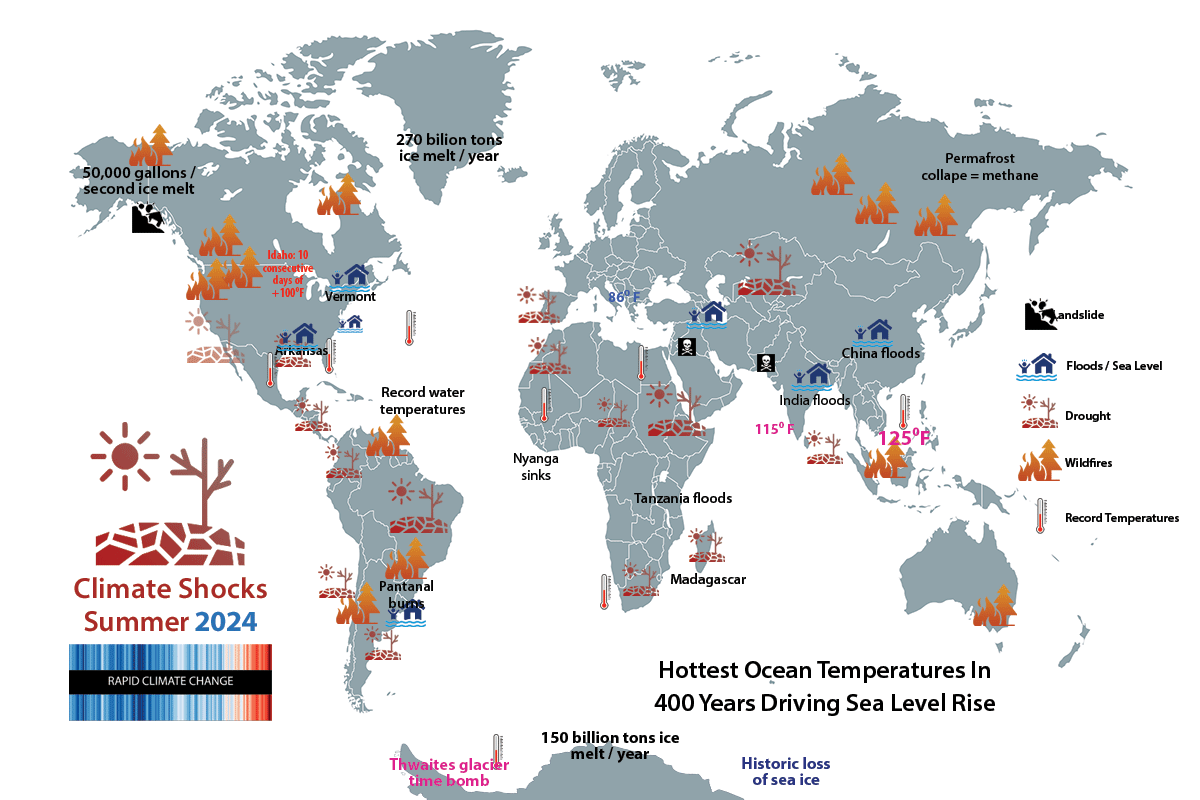
Las Vegas never got below 94.7°F (even at night) for two weeks
Heat records were smashed across the USA as a record breaking hurricane tore through the Caribbean and Gulf of Mexico. The average temperature for the previous 12 months has been at least 2.7°F (1.5 C) warmer than the 1850-1900 pre-industrial average. Extreme weather disasters cost China $13 billion the first half of 2024, Swarms of toxic algae are moving toward the poles as seas warm, US coastal sea level rise exceeds projections, water wars in Idaho are a microcosm of global conflicts. Hundreds of wildfires were torching Alberta, California, Oregon, Washington and Idaho, collapse of permafrost has dozens of unanticipated consequences, Methane levels rising at new record highs, a record number of acres has already burned in the West, Permafrost melt may be adding Mercury into rivers and bays, Greenland is currently losing 270 billion tons of ice per year, more landslides and flooding in India kills dozens, sea surface temperatures are near 98F, Costa Blanca is out of drinking water, climate driven landslides increasing in Alaska, 200,000 evacuated in Nigeria after weeks of flooding, crazy ass weather in the Sahara reflects new patterns, Central and Eastern Europe are hit by Boris, killing dozens, South America burns as half of Brazil is in exceptional drought, beach houses keep falling into the Atlantic Ocean in North Carolina, Methane emissions are continuing to increase, Tens of thousands are evacuated from record rainfall in Japan, melting permafrost is releasing mercury and other toxic chemicals.
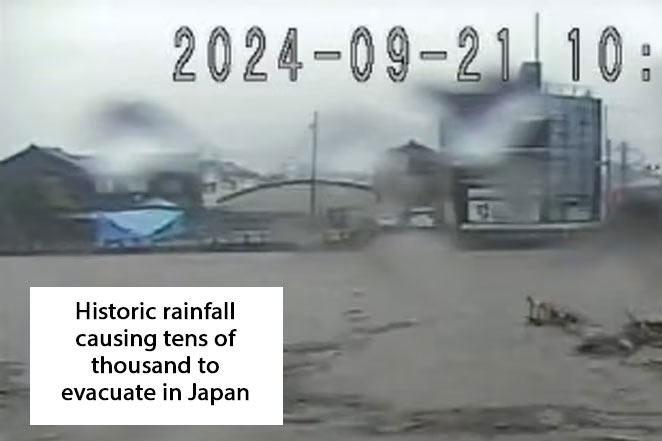
Japan: record rains driving evacuations
Killer floods and landslides
The unprecedented caused the Japan Meteorological Agency to issues issue the highest alert for heavy rain across several cities in the Ishikawa prefecture.
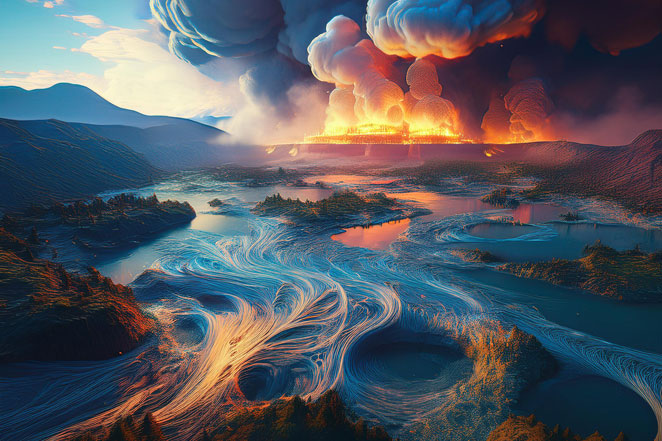
Alarming global Methane emissions
30x more powerful GHG than CO2
New research shows the United States and its fossil-fuel industry continue to spew more and more dangerous methane, along with the other gases they spew from their highly paid misinformation operatives. The US initiated the “Global Methane Pledge” to cover up the fact that they are increasing rather than decreasing CH4 levels.
Global average methane concentrations in the atmosphere reached 1,931 ppb as of January this year. The previous level, published in 2020, reported levels at 1,875 parts per billion. This is more than two-and-a-half times preindustrial levels.
It is true that over than half of the world’s methane emissions are generated by humans, but also note that the collapse of Arctic permafrost is releasing increasing quantities of CH4 as they are released from the once frozen soil.
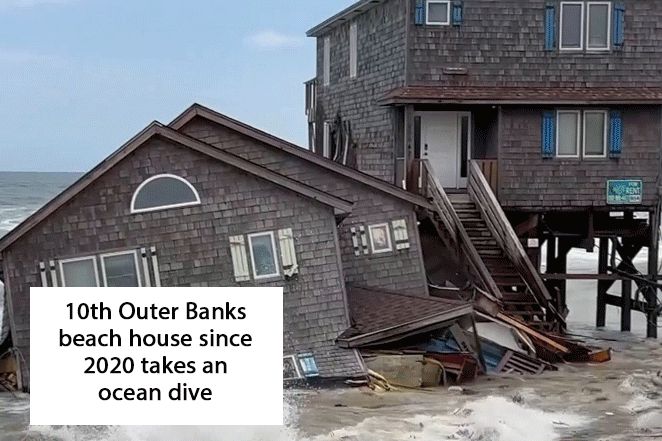
More OBX houses take an ocean dive
3 more OBX houses in 4 days
After three more Outer Banks home collapsed into the ocean in late September, the totals look like this:
- 3rd collapse in 24 hours
- 4 OBX collapses in six weeks
- 10 OBX collapses in 2020. Cleanup is underway after another Outer Banks home collapsed into the ocean on Friday night.
“People say hateful things and ask why we built our house in the middle of the ocean,” said one homeowner.
Yeah. This came as a surprise, right?
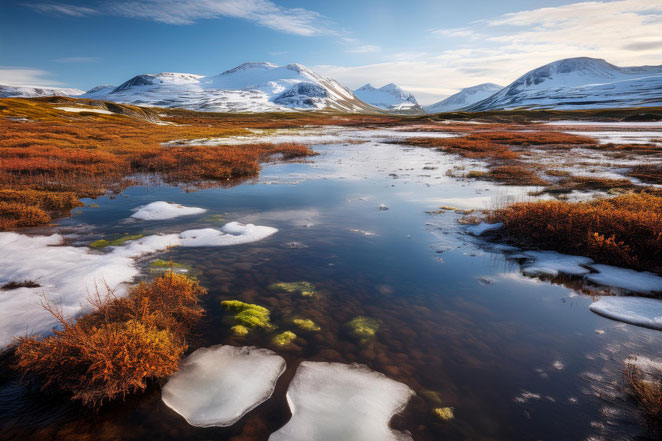
Permafrost melt also releases toxins
Beyond methane and CO2
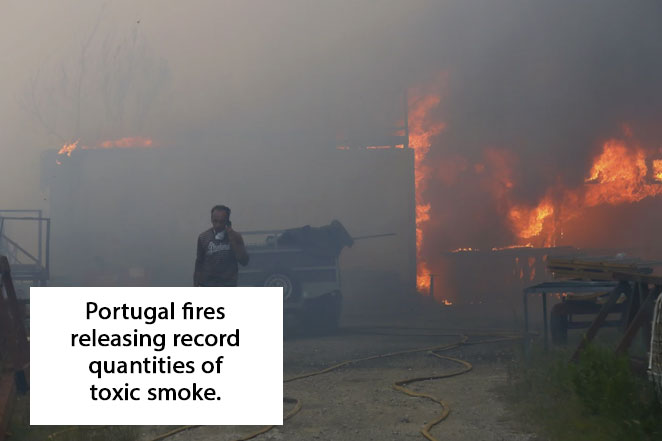
Record emissions from Portugal fires
Weeks burning out of control
Deadly wildfires raging in northern Portugal have released record emissions, according to the Copernicus Atmosphere Monitoring Service (CAMS).
The unseen danger of these emissions are both CO2 and nasty particulate matter pollutants like PM10 and PM2.5.
PM2.5 is made up of particles 2.5 microns or smaller, making the potential implications for public health more significant because they penetrate the respiratory system and potentially enter the bloodstream.
Civil Protection has registered five deaths, excluding two civilians who died of sudden illness linked to the fires. Three of those killed were firefighters tackling the blazes. Over 150 more people have been injured, 12 of them seriously.
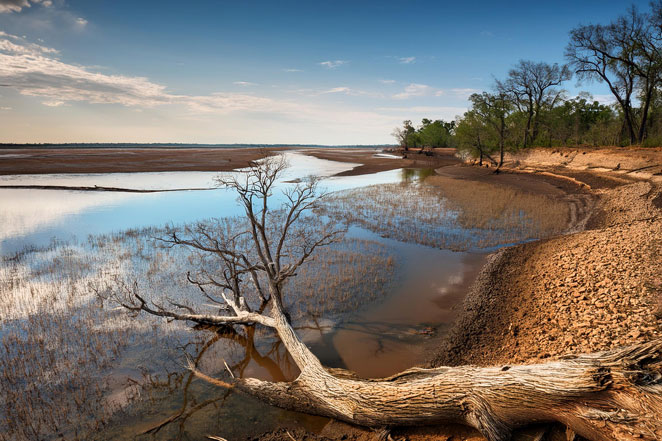
Mississippi shipping threatened by drought
Critical river traffic under siege
Like many effects of global warming, this one is not obvious. Low Mississippi River levels are again making it more expensive to transport crops in the Midwest, as the key waterway faces another year of drought.
Although not yet the crisis seen in 2022, the Mississippi River is again experiencing low water levels, driving up grain transportation prices for farmers in the Midwest.
It’s the third year in a row that drought has impacted the river system
When water levels are low, barges can’t carry as much grain, because they could run aground in the shallower water. There are also navigation issues as the lower water levels lead to a more narrow channel.
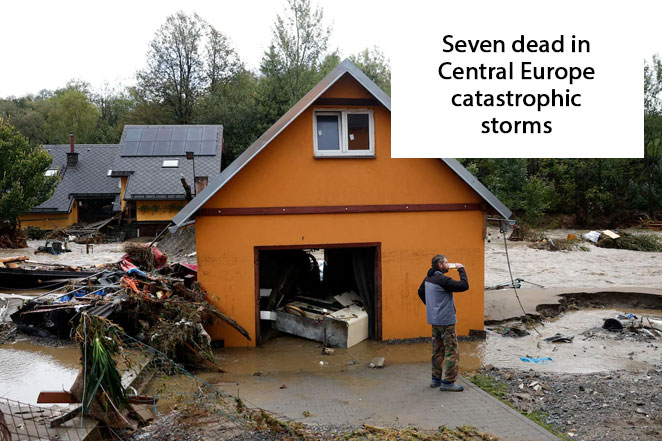
“Apocalyptic” Boris kills dozens in EU
10,000 evacuated
A bizarre later summer storm system has caused massive flooding resulting in the deaths of at least seven and evacuations across Central and Eastern Europe.
Floods and unseasonable snow have hit Austria, the Czech Republic, Germany, Hungary, Poland, Romania and Slovakia.
Forecasters have decided this storm is named Boris. Some The storm, which some forecasters named Boris, was caused by Arctic air sweeping south through Europe and running into warmer air. The weather system also buried many towns in snow.

Global food supply fraying as heat looms
Multiple factors threaten agriculture
The accelerating climate emergency poses a significant threat to the global food supply, with both direct and indirect effects on crops, livestock, and fisheries.
Planet wide heating is already having far-reaching effects on the global food supply, impacting crop yields and increasing food insecurity. These impacts are shaped by rising temperatures, changing precipitation patterns, more frequent extreme weather events, and increasing levels of atmospheric carbon dioxide.
The climate emergency affects crop yields due to extended heat waves and water scarcity, extreme weather and unpredictable precipitation patterns. Often overlooked, nutrient content in staple crops may also be affected. Crop yields may even increase due to higher CO2 levels, but actual nutrients may decrease, resulting in more empty calories.
In addition, warming lake and ocean waters are stressing marine life, which affects fisheries and aquaculture. Increased CO2 levels in the ocean are causing fundamental changes to acidity.
The range of crop destroying insects and other pest is migrating toward the poles.
As luxury goods and basic stables become more expensive and then unavailable, it will become increasingly challenging for paid climate deniers to keep up the lies.

South America continues to burn
Half of Brazil is in severe drought
from Brazil’s Amazon rainforest to the world’s largest wetlands to super dry forests in Bolivia an unprecedented onslaught of wildfires is smashing all time records. Brazil’s space research agency Inpe reports 346,112 fire hotspots so far this year in all 13 countries of South America. This alarming statistic breaks the 2007 record of 345,322 hotspots.
Ecuador has cut power to half the country due to extreme drought. Colombia was fighing out of control burns across seven states.
Meanwhile, in related news, rampant de-forestation has driven half of Brazil into serious extended drought.
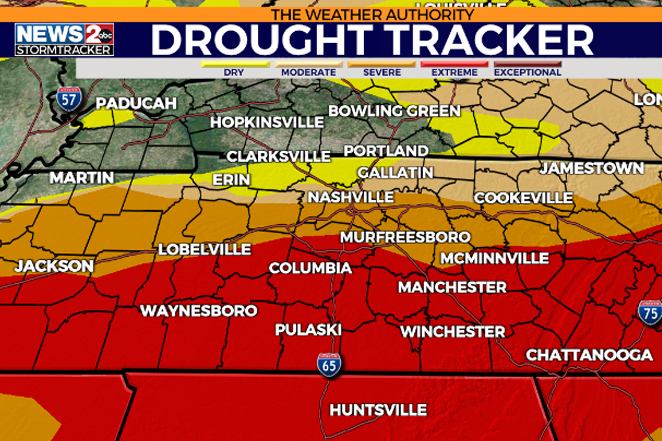
More Tennessee towns out of water
Franklin & Portland, TN
Two towns in central Tennessee are running out of water in the midst of a drought that has challenged water supplies across the state.
An Emergency Status 1 Water Shortage has been declared in the City of Franklin Water Utility District and Portland
Officials announced the shortage on Wednesday, Sept. 4, stating the city serves approximately 18,500 customers in the Franklin area
About 2.1 million Tennessee residents are experiencing dry conditions brought on by excessive heat and limited amounts of rainfall, according to drought.gov.
Nashville and Williamson County area are both classified as abnormally dry, but other areas of Tennessee, such as Hickman County, are experiencing extreme levels of drought, conditions favorable for crop loss and wildfires.
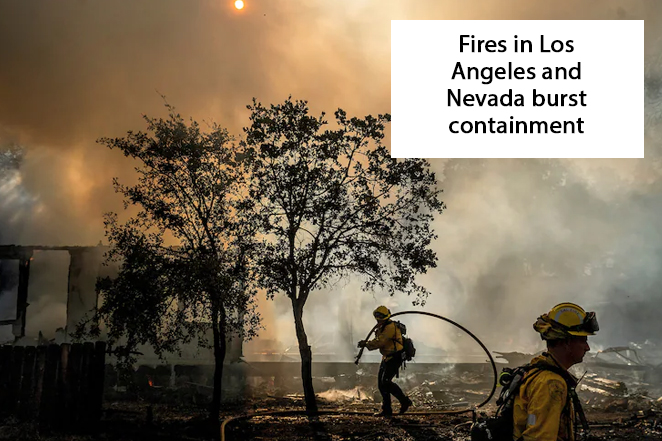
Explosive SoCal, OR & Nevada fires
Evacuations in CA, OR and NV
Firefighters are battling an eruption of wildfires in the western United States this weekend, with flames ravaging thousands of acres and triggering evacuation orders across California, Oregon and Nevada.
The Line Fire has triggered the evacuation of 6,000 residents. The blaze quadrupled in size as the weekend began, scorching thousands of acres on Saturday alone. The flames raced up steep terrain, chewing through thick vegetation as they approached Running Springs, a mountain community of about 5,000 people that lies between the populated resort areas of Lake Arrowhead and Big Bear Lake. By Sunday evening, Cal Fire estimated that the blaze threatened more than 36,000 structures, including family homes and businesses.
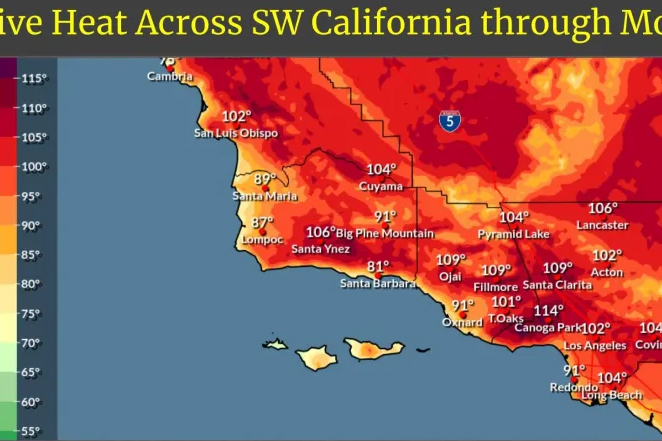
100°F at midnight in SoCal
Overnight temps more dangerous
Temperatures hovered above 104°F on the California coast early Friday, creating unbearable conditions past midnight as officials warned that the excessive heat would last through the weekend.
The nighttime heat ranged from the upper 80s to the 100s across the coasts of Santa Barbara, Ventura and Los Angeles Counties, according to the National Weather Service.
Such high temperatures happen at that time of night there about once a year, Bryan Lewis, a meteorologist at the National Weather Service office in Oxnard, Calif., said in a phone interview.

200,000 displaced in latest Nigeria flooding
Hundreds dead after rains and floods
Weeks of flooding have killed nearly 200 people in Nigeria and washed away homes and farmlands, the country’s disaster management agency said, further threatening food supplies, especially in the hard-hit northern region.
The floods have destroyed 107,000 hectares of essential in the north, the source of much of the country’s ag output. Nigeria has the highest number of hungry people in the world, with 32 million — 10% of the global burden — facing acute hunger.
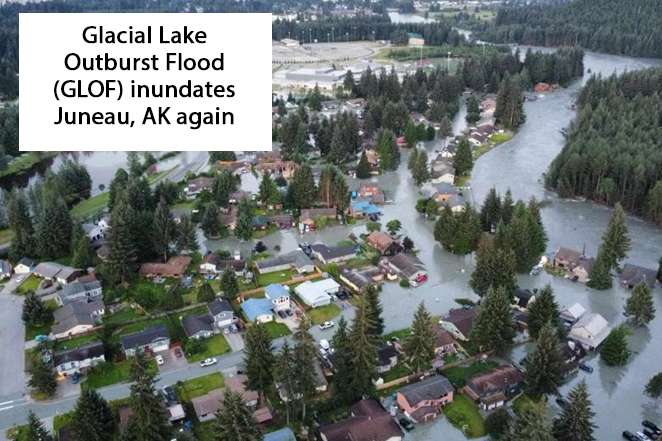
Glacial lake floods getting serious in Alaskan capital
Global phenomenon increasingly dangerous
As glaciers melt at a frenetic pace around the planet, new lakes back up behind newly formed ice dams. When the dams break, the water rushes downstream, often in a cataclysmic flood.
In a repeat of a 2023 catastrophe, an “outburst flood” from the Mendenhall Glacier has sent millions of gallons of rock and water into a neighborhood in Juneau. About 100 homes were evacuated and a state of emergency was declared. According to authorities, shocked residents managed to swim out of their homes in the middle of the night.
Two miles from the end of the Mendenhall Glacier, ice dams blocks Suicide Basin valley, an open space left after the glacier melted away..
For the past decade, the valley has filled with rain and meltwater as the glacier recedes. . Then the water burrows a tunnel into the ice dam, which eventually breaks through and pouring into the city below.
As glaciers melt at a frenetic pace new lakes back up behind newly formed ice dams in the Andes, Alps and Himalayas. When the dams break, the water rushes downstream, often in a cataclysmic flood. These floods have become more common as global warming causes rapid melting of glaciers around the world.
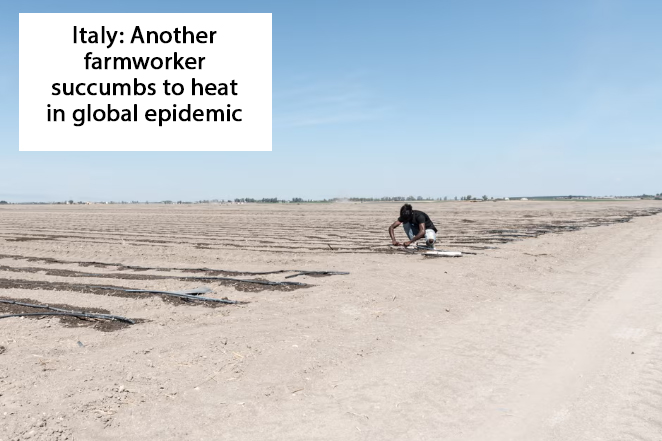
Latest worker heat death in Italy reflect global problem
104°F as “farm slaves” succumb
This time it’s Italy, but the brutal treatment of migrants working fields around the world is echoed everywhere from Saudi Arabia to Texas. The latest report concerns a flower picker working in 104°F temperatures in the most recent heat onslaught in southern Europe. has been shocked by reports of the “brutal” treatment of migrants working on farms across the country and the death of a flower picker in temperatures of about (104F). Tens of thousands of migrants have been taking to fields to pick tomatoes and other crops across Italy at the same time as the country has been engulfed in consecutive heatwaves since the middle of June.

42,000 Amazon fires are crime and climate driven
Setting fire to our own planet
Out of sight out of mind for the thousands of fires destroying the Amazon forest. However, the situation got someone’s attention in Brasilia because people in the capital can’t breathe. The huge area of out of control conflagrations affects central Brazil, Cerrado savannah, the Pantanal wetland and the state of Sao Paulo.
Many of the fires appear to be set by humans, perhaps in a coordinated effort. August has seen 3,500 fires so far. The smog caused 48 cities to declare a red alert.
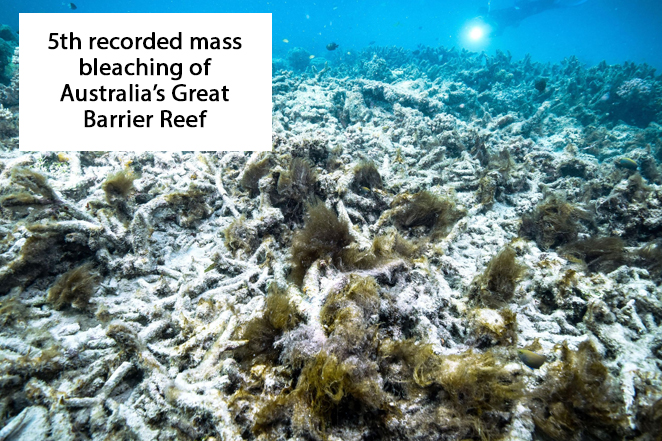
Great Barrier Reef coverup: it’s bad
Government report downplays damage
Ocean temperatures in the Great Barrier Reef are now the hottest in at least 400 years and are an “existential threat” to one of the planet’s iconic natural places.
The new research, published in the prestigious journal Nature, concludes the “existential threat” to the reef from the climate crisis is “now realized. We will likely be witness to the demise of one of the Earth’s natural wonders.”.
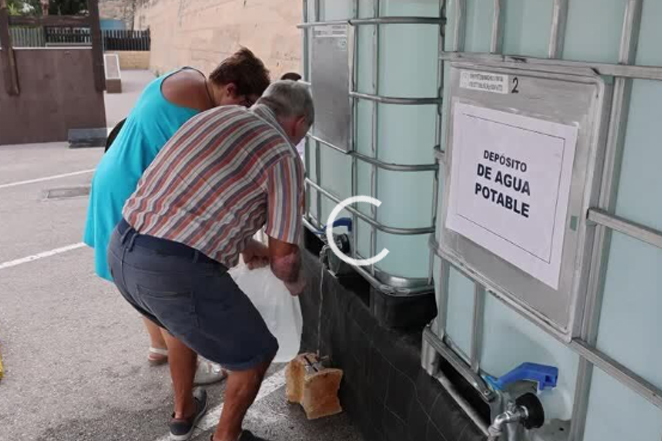
Out of water in Costa Blanca tourist town
Visitors are lining up to buy bottled water
Relentless drought is hurting the tourist business in Spain’s popular Costa Blanca travel destination. Tap water has been become undrinkable in several towns along the coast, forcing visitors and residents to line up distribution points for bottled water to cover their basic needs.
The town has also had to ban the filling of swimming pools.
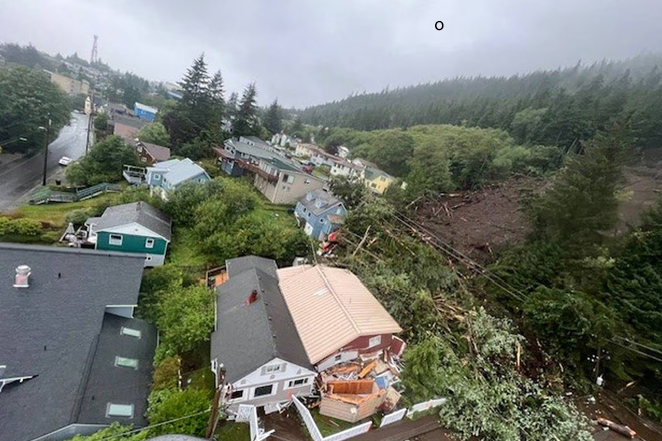
Increasing Alaskan landslides driven by record rains
Incidents increasing as storms intensify
A landslide crashed through the forest above Ketchikan, AL, destroying homes and killing at least one person. The incident is the most recent in a series of storm driven collapses that have increased over the past decade. Sixty homes were evacuated as the slope remained unstable.
Four homes were critically damaged, officials said, and homes next to the slide area were still being assessed. Several homes and businesses reported flooding.
Last November, six people — including a family of five — were killed when a landslide destroyed two homes in Wrangell, about 100 miles north. Torrential rains were blamed for landslides that killed two people in Haines in 2020 and three people in Sitka in 2015.
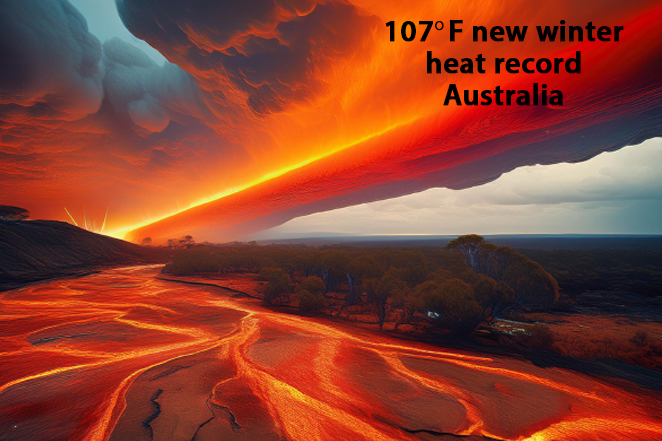
107°F breaks record as Australian winter ends
Hottest ever winter temperature
The temperature is the hottest every recorded on the continent for any winter month (which as a reminder, is the seasonal opposite of the Northern Hemisphere).
Records are also being broken in Queensland, Western Australia, Northern Territory and New South Wales.
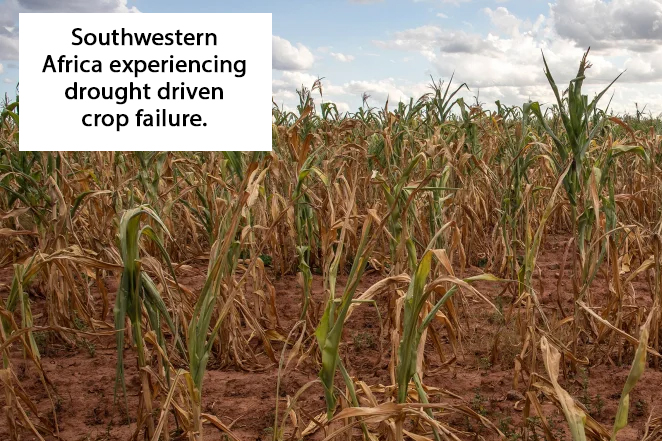
Namibia drought drives wild animal food service
Starving animals will feed starving people.
Namibia has declared a state of emergency due to the historic ongoing drought in the southwest regions of Africa. Over a millions people are going hungry as crops fail. Meanwhile animals in the national parks are also suffering. As a result, the Ministry of Environment, Forestry and Tourism announced has announced that 700 wild animals will slaughtered and used to feed the hungry.
The hunt will include 83 elephants, 30 hippos, 60 buffalo, 50 impala, 100 blue wildebeest and 300 zebras
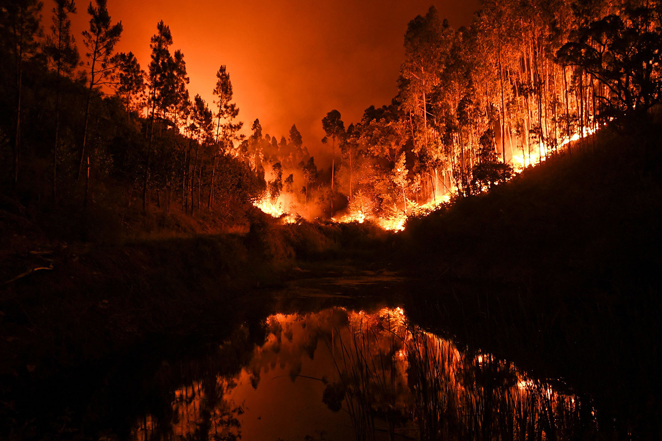
Portugal wildfires threatening national forest
Brazilians can’t breathe as forest burns
Firefighters on the Portuguese island of Madeira are battling the country’s worst wildfire since 2017. The island of Madeira – a UNESCO listed forest is threatened by the blazes.
The country has not seen a fire of this scale since 2017, when it recorded its deadliest blazes.
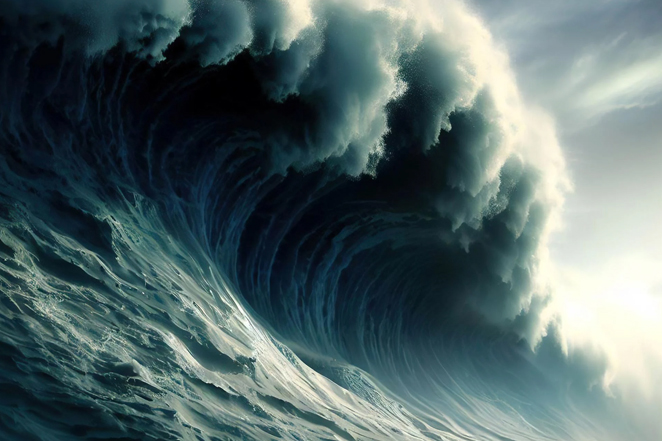
350 ft high Greenland mega-tsunami was landslide driven
Solar generation keeping grid stable
With very little media attention, the east coast of Greenland was hit by a megatsunami that was over 350 feet high, wiping out a military base in the process.
A new study published in The Seismic Record, warn that climate change is accelerating the melt of Greenland’s glaciers and permafrost, increasing the chance of landslides and subsequent mega-tsunamis.
Smaller events have been observed a number of times in recent years, such as the rock avalanche into western Greenland’s Karrat Fjord in 2017, which triggered a tsunami that flooded the village of Nuugaatsiaq, destroying 11 houses and killing four people..

34,000 Evacuations in India landslides
At least ten dead after landslides
At least 10 people have been killed, and one person remains missing, following a series of landslides and flood-related incidents across the northeastern state of Tripura due to heavy rainfall since Sunday, August 18, 2024. The flooding has caused the displacement of over 34 000 individuals so far.
The heavy rainfall that began on Sunday, has caused the water levels in all major rivers in the state to rise above the danger mark, resulting in widespread flooding across several areas. According to official reports, more than 34 000 people have been displaced, with 34 100 individuals from 6 620 families taking refuge in 346 relief camps across eight districts.
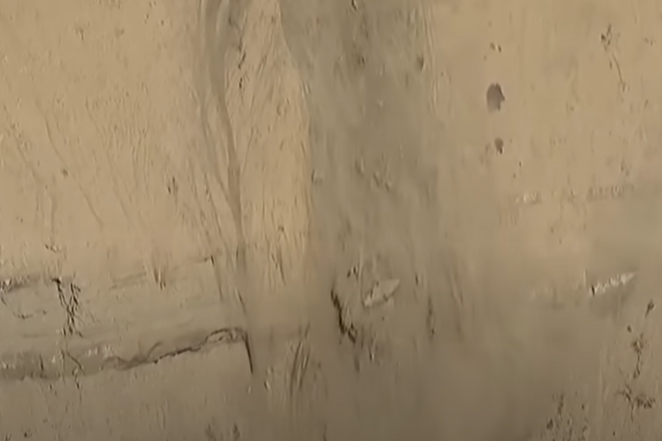
And California continues to dissolve into the ocean
Beaches houses on both coasts reclaimed
A bluff collapsed Monday near Torrey Pines City Beach in La Jolla.
Around 4:12 p.m., SkyFOX/KUSI in the Sky captured video of sand and rocks falling down the cliff for at least two minutes, sending a plume of dirt into the air.
While construction, landscaping, and other human activities near bluffs can exacerbate natural erosion. Climate Change is also a major driver: Rising sea levels and more intense and frequent storms an lead to more rapid bluff retreat.
Periods of heavy rain, particularly during El Niño events, saturate the soil, making it heavier and more prone to sliding or collapsing.
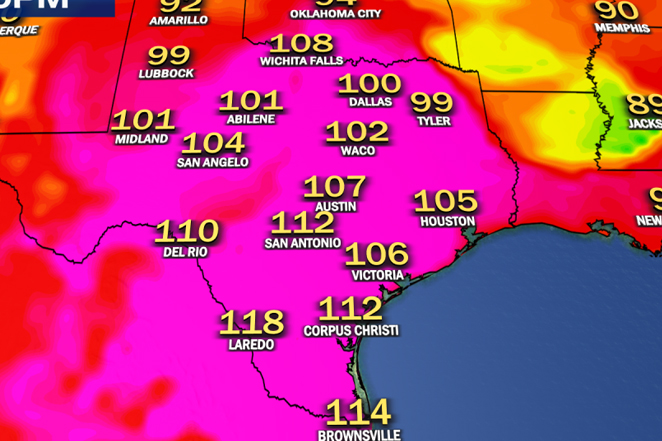
Relentless Texas heatwave as Houston reports 116°F.
Solar generation keeping grid stable
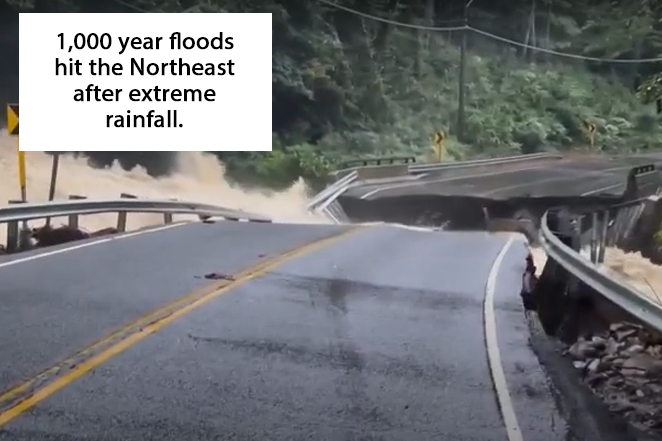
1,000 year floods in US northeast wreak havoc
At least three dead
A mid-August extreme weather event deluged two locations in the Northeast with rainfall rates that are supposed to happen only every thousand years.
The storm killed at least three people and caused widespread flooding. It dropped about 10 inches of rain over 12 hours on Sunday in parts of Connecticut and about 6.7 inches of rain fell in 3 hours in Stony Brook, New York.
Climate change has made more severe storms far more likely in the Northeast because a warmer atmosphere can hold more water.
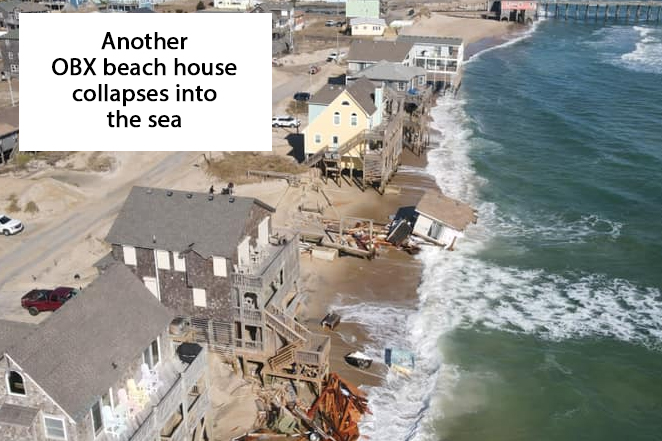
The ocean eats another OBX home
Seventh to collapse into the sea
“In their case, they kind of ran out of time. It happened quicker than they thought.”
And yet the residents seem surprised. Not only surprised, they want help from taxpayers. No.
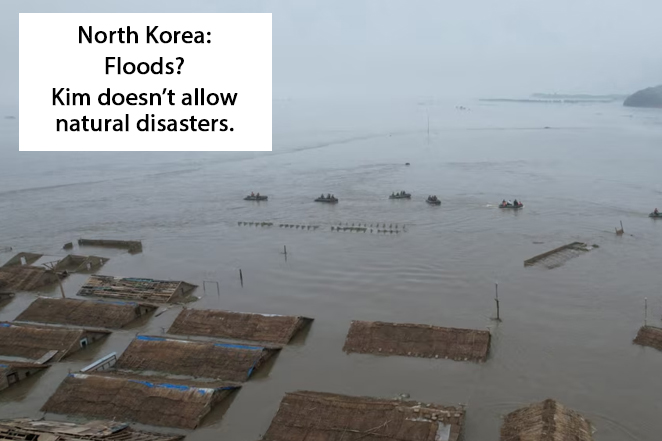
North Korea flooding disaster is a secret
Human cause, nature execution
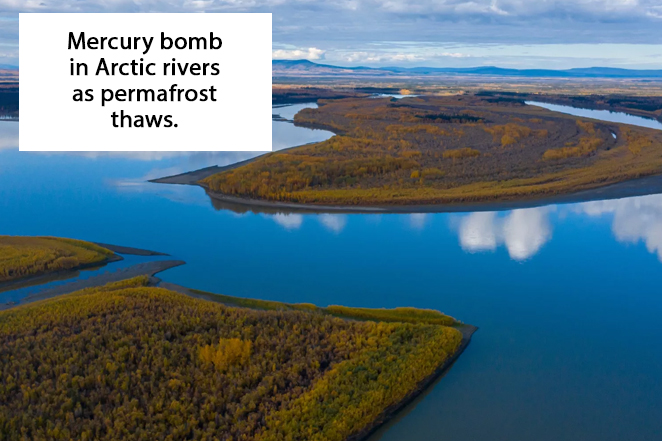
Permafrost’s latest surprise may be most deadly
Mercury leaching into waterways
It has become relatively common knowledge that the accelerating collapse of Artic permafrost is creating unintended consequences. In the dramatic column is the release of CO2 and especially Methane (CH4). As the once solid ground collapses, the greenhouse gases trapped for thousands of years emerge.
And now, a new unanticipated consequence as Arctic riverbanks erode rapidly, releasing mercury – a deadly poison – into the rivers and seas.
The rivers of the region are eroding permafrost on the banks faster and releasing a toxic metal into the environment – mercury. Recent reports warn that we are NOT YET looking toxic threat today,, the newly released toxins accumulates in the food chain.
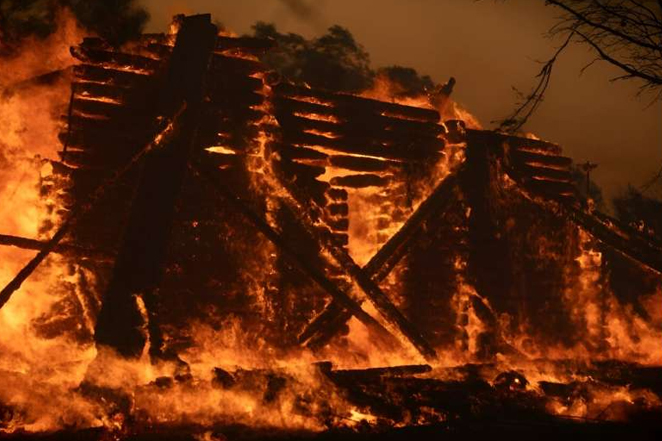
Evacuations in Athens ‘burbs flee 80 ft. flames
“Every year we have to escape from our houses.”
Hundreds of people were evacuated from Athens suburbs as another wave of wildfires hit Greece and the southern Mediterranean region.
Hundreds of Greek firefighters supplemented by newly arrived reinforcements from other countries reported fighting 80 ft. high walls of flame.
The wildfire disaster was exacerbated by 102°F temperatures.

Lethal combo platter of climate and negligence
Landslide is driven by extreme rain events
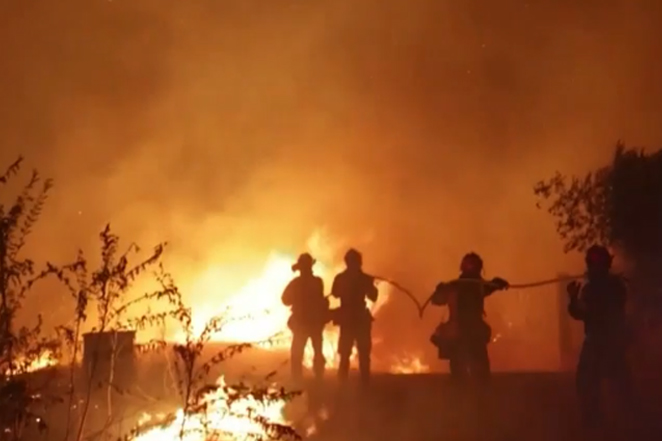
Turkey engulfed in wildfire onslaught
Heat and wind driving walls of flames
Wildfires have engulfed swaths of western Turkey triggering the evacuation of nearly 4,000 residents.
On the west coast, a fire threatened houses on the outskirts of Izmir, Turkey’s third largest city, where a blaze broke out in the woods Thursday night. Residents fled their homes as ash fell around them.
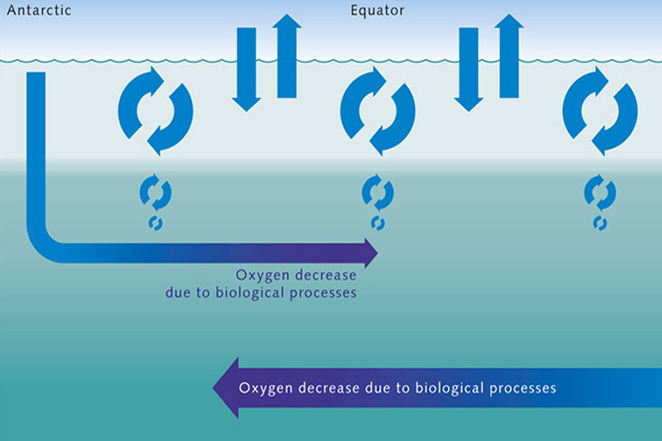
Oceanic Oxygen dropping as CO2 increases
More dead zones, more messed up marine life
Oxygen concentrations in our planet’s waters are decreasing rapidly and dramatically—from ponds to the ocean. The progressive loss of oxygen threatens not only ecosystems, but also the livelihoods of large sectors of society and the entire planet, according to the authors of an international study involving GEOMAR published today in Nature Ecology & Evolution.
The flip side of decreasing Oxygen is increasing Carbon Dioxide. This ongoing disaster is changing the pH level of the seas, which in turn creates acidification. There is no scenario in which this is good for marine life.
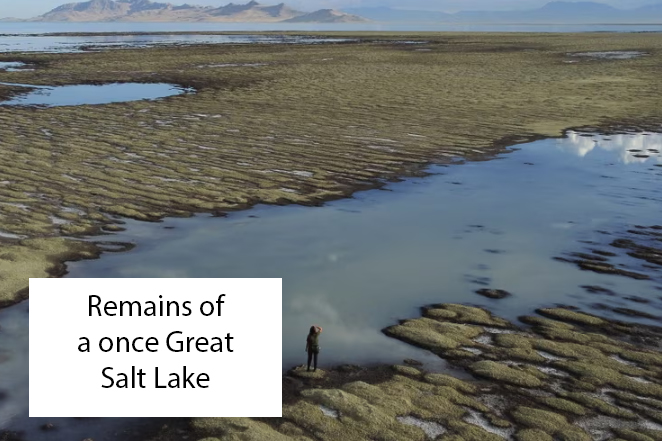
Great Salt Lake: less great, more salt
Iconic lake has lost 73% of its water
The collapse of Utah’s Great Salt Lake is little noted even within the region, even as the shrinking lake creates toxic dust storms, disappearing habitats and more food challenges for migratory birds.
The most recent report tells us the Great Salt Lake’s lakebed emitted carbon dioxide and methane that equaled 4.1 million tons of carbon dioxide.
The state of Utah received federal money to study the effects of the toxic dust created by the dying lake, but has not done anything about it. Hmmm
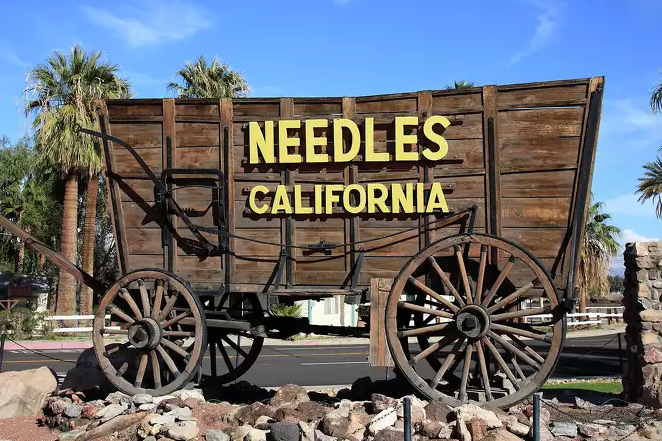
103.2°F sets new record for highest average temp
One month average for day and night
Phoenix’s record for the highest monthly average temperature for a US city was smashed in July by the sustained 24 hour heat onslaught in Needles, CA. The desert enclave recorded a preliminary average monthly temperature of 103.2°F degrees for the month, meaning that daily highs and lows averaged out to well over 100°FThis surpassed the previous monthly temperature record of 102°F degrees set in Phoenix in 2023.

Methane levels spiking at new record highs
Extraction industries flaunt regulations
A new study reports a serious uptick in global emissions of methane (CH4), a planet-heating gas considerably more dangerous than CO2. The rate of growth is accelerating and has seen an alarming bump in the last few years.
Methane emissions are responsible for about half of the global warming already baked into the climate catastrophe and began a new leap around 2006.
Published in Frontiers of Science, the paper points out that methane is about 80 times more potent than carbon dioxide, although it dissipates faster than CO2. For all practical purposes, carbon dioxide (which continues to climb with no sign of abatement) forever.
There are many sources of methane, including fracking and gas sites around the world that are essentially unmonitored. Unknown quantities of CH4 are lurking beneath rapidly thawing Arctic permafrost.
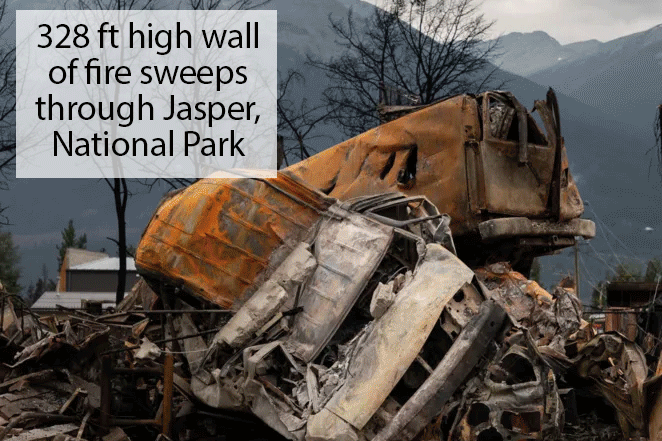
25,000 evacuated as 325 ft. flame wall torches Jasper
A new era in wildfire intensity and damage
The historic resort town of Jasper, AB and the the national park were laid waste by a 325 ft. wall of fire that swept through in late July, melting cars, engulfing buildings and infrastructure with apocalyptic heat. About a third of the homes in the town were incinerated.
As of late July, there are about 50 megafires burning “out of control” around the province of Alberta as the region endures the continuation of annual fire problem that seemingly has no end.
These disasters are now reflecting broader global trends in wildfire behavior. The causes are warmer temperatures, prolonged droughts, and earlier snowmelt.
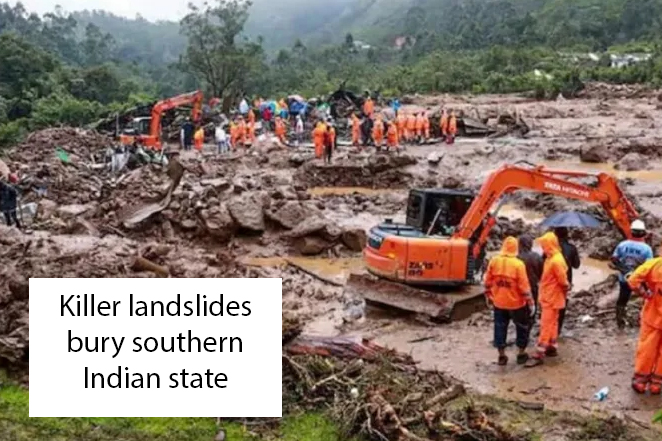
Over 100 dead in India landslide catastrophe
Unrelenting extreme weather patterns
At least 110 people have died with dozens more missing after global warming driven heavy rains caused landslides in the Indian state of Kerala. Roads and bridges were destroyed throughout the state,
The events were triggered by unrelenting rains in the region of of tea plantations, collapsing hillsides and launching fast moving deluges of mud, water and tumbling boulders.
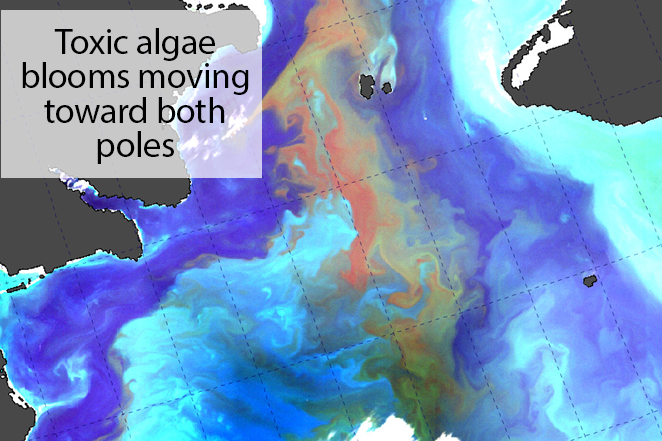
Toxic Algae moves into polar waters as seas warm
New climate change threatens poles
The toxic algae live form known as a. catenella have increasingly threatened fisheries and tourism in the middle latitudes. Now they are moving north, as are thousands of other species of everything.
The blooms can lead to paralytic shellfish poisoning (PSP) and threaten a wide range of marine life. The blooms can lead to paralytic shellfish poisoning (PSP) and threaten a wide range of marine life. In addition to warming waters, the introduction of fresh water from melting ice caps creates conditions conducive to A. catenella growth.
This year, scientists are investigating new reports in Alaska and Scandinavia, as well as toxic outbreaks moving into Antarctica.
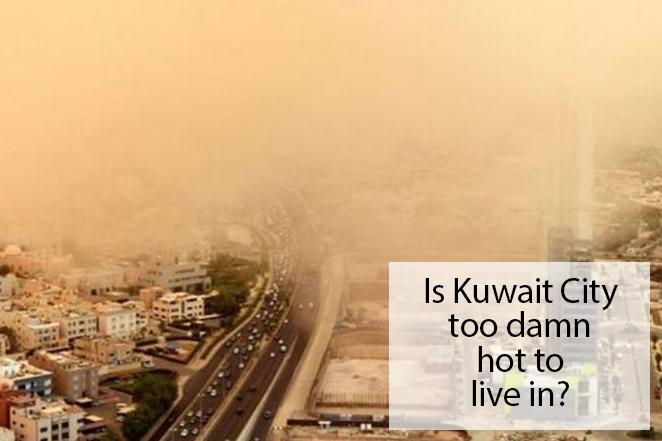
Kuwait boils as dead birds fall from the skies
Unusual weather, ain’t it?
While sea horses cooking in the sea is not mentioned in Book of Revelation, the situation in Kuwait City is rapidly approaching End of Days levels as extreme heat becomes deadly. During the summer months.as the already arid nation is receiving less rainfall each year and more and more severe dust storms..
There have been alarming incidents of birds dropping dead from the sky and seahorses being boiled alive in the Persian Gulf. Temperatures reaching 129°F are not just uncomfortable, they’re hazardous. These temperatures are well beyond what the human body can tolerate and leading to heat exhaustion, heart problems, and death..
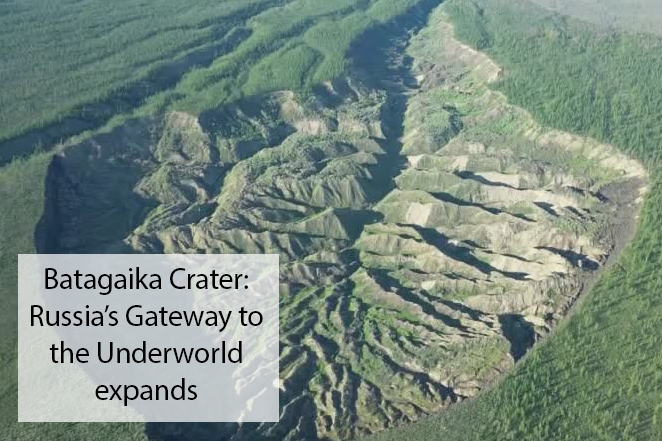
Permafrost collapse: a triple tipping threat
As the tundra thaws quickly, danger lurks
Arctic permafrost is experiencing galloping thawing, causing consequences that are accelerating global warming in a series of feedback loops. Some effects are obvious, especially the increasing release greenhouse gases like methane and carbon dioxide.
More on megaslumps, collapsing infrastructure and underwater methane geysers.
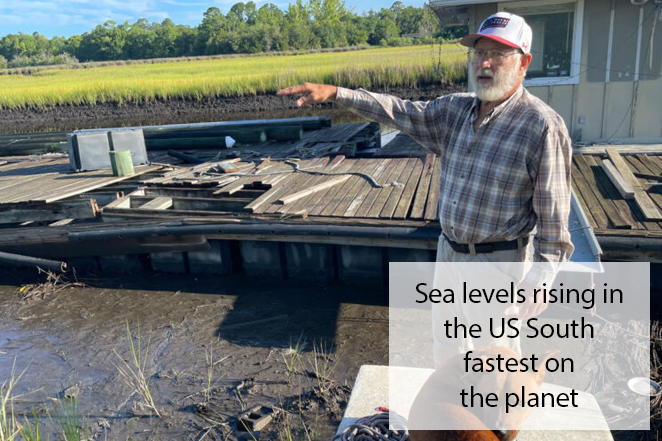
Sea level rise in the south most extreme on earth
“I think people just really have no idea what is coming, because we have no way of visualizing that through our own personal experiences” – Randall Parkinson
Across the American South, tides are rising at accelerating rates that are among the most extreme on Earth, a new surge that is about to get real in terms of insurance rates and lifestyles.
Since 1900, sea levels have climbed worldwide by about 1.5 mm a year. That’s about twice the thickness of a credit card. Not much but in a decade, it’s about half an inch. That pace is the fastest at least 3,000 years. Since the middle of the 20th century the rate has accelerated to beyond 3 mms a year.
In the South the pace has jumped from about 1.7 mm a year at the turn of the 20th century to at least 8.4 mm by 2021. In Pensacola the rate soared to roughly 1/2 in. (11 mm) a year in 2021.
In addition to the obvious effect of melting polar and alpine ice, thermal expansion of the oceans is also a major (albeit less intuitive) contributor to rising oceans.
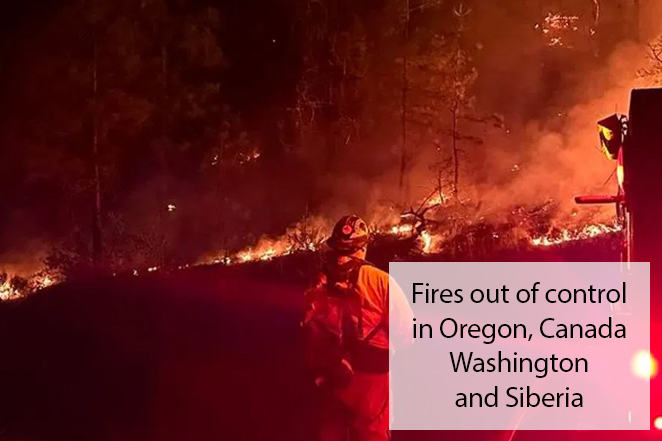
Oregon, Washington, Canada megafires redux
Toxic smoke moves into North America
A reboot of last year’s horrific wildfire season in North America is shaping up in mid-July as toxic smoke begins to waft south and east.
In the “how ironic” category, petro province Alberta has seen forced. Five separate fires are burning. In British Columbia up to 319 active wildfires are burning; evacuation orders were issued due to several uncontrolled fires.
In Washington State, 450,000 acres have been torched by 24 large fires with another 17 large fires burning in Oregon. The largest is the Cow Valley Fire at 131,490 acres.
The 2024 wildfire season has burned 618,741 acres or 866 sq miles in Oregon, including four new mega fires!
9,000 people have been evacuated in Northeastern Canada a region not typically afflicted by wildfires.

Water wars in Idaho as reality sets in
Looking a loss of crop seasons
Water conflicts in the US West have along history, but the current situation in Idaho provides a more urgent example of the results of global warming and unenlightened self interest. Although it appeared a few years ago that some resolution was possible Water users in the West have a long history of conflict over water rights, but the last couple of years in Idaho seem to have unraveled an unprecedented agreement that calmed the waters for a bit.
The result was that the Idaho Department of Water Resources (IDWR) issued a water curtailment order on May 30, 2024, meaning junior groundwater users were facing the possibility of destruction of 2024 crops, which would result in financial ruin.
The issue stems from an agreement made in 2016, which aimed to stop aquifer water loss and recharge the aquifer. Conditions have since gotten worse, and support of the agreement has collapsed.
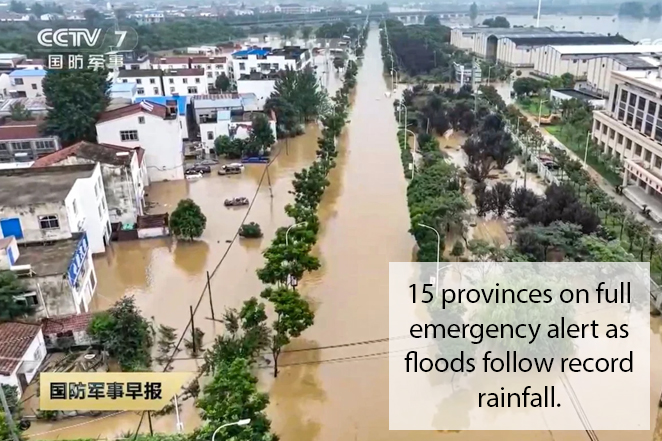
China hammered by more catastrophic flooding
Climate whiplash continues
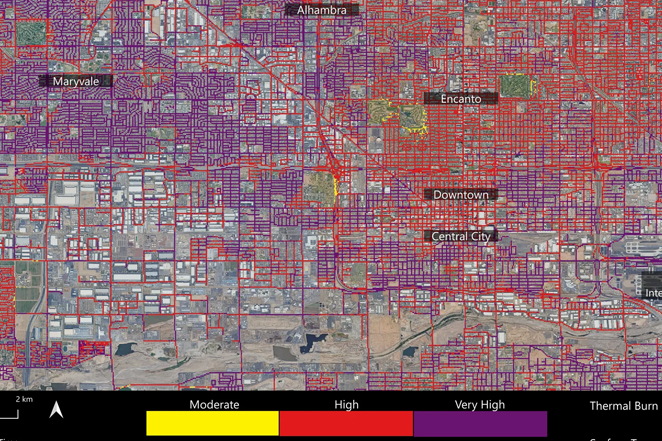
Satellites map 160°F on Phoenix surfaces
Unusual weather, ain’t it?
According to recent NASA satellite measurements, streets and sidewalks in Phoenix can reach 160°F, literally hot enough to fry an egg or your foot. Hospitals and emergency clinics in America’s hottest city are noting an increase of patients with serious burn injuries.
NASA’s Jet Propulsion Laboratory mapped the thermal burn risk across the city by measuring the surface temperature with satellite platformed infrared sensors.
Human-caused climate change is increasing the intensity and duration of heat waves in Phoenix,
July brought a month-long streak of days over 110 degrees. Hospitalizations from heat-related illnesses rose, and residents turned down their thermostats waiting for a reprieve. Even the state’s iconic saguaros, cactuses that are adapted to the heat, began collapsing from scorching temperatures and lack of monsoon rains.
Temperatures peaked at 119 degrees three times, and July became the hottest month on record for a U.S. city. This year, Phoenix recorded 54 days at or above 110 degrees, breaking another record.
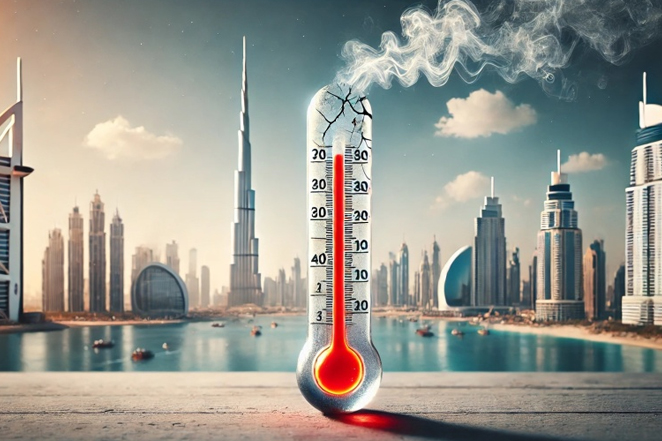
Dubai/Gulf record life threatening144°F heat index
Approaching the limits of human survival
Dubai is experiencing an intense heatwave with the “feels like” temperature soaring to 62C (143.6 Fahrenheit), according to US-based weather reports. Air air temperature was 109°F and a dew point of 85°F produced the 144°F reading, which is beyond the theoretical limit of human heat tolerance.
The so-called wet-bulb temperatures of over 35C are lethal for humans if exposed to them for more than six hours. The wet-bulb temperature is a measure that accounts for both heat and humidity; when humidity approaches 100% sweat no longer evaporates, preventing the body from cooling down with deadly results if exposed to these conditions for too long.
The insane heat indexes have afflicted the entire region, with “real” temperatures in Asaluyeh, Iran, at climbed to 108 (42 C) on Wednesday and 106 (41 C) on Thursday, with both days recording a peak heat index of 149 (65 C). In Dubai, the temperature topped out at 113 (45 C) on Tuesday and the heat index soared to 144 (62 C). Other extreme heat indexes in recent days include 141 (61 C) in Abu Dhabi and 136 (58 C) at Khasab Air Base in Oman.
A few months ago, the city was smashed by catastrophic rainfall, most likely caused by it’s own weather geoengineering.
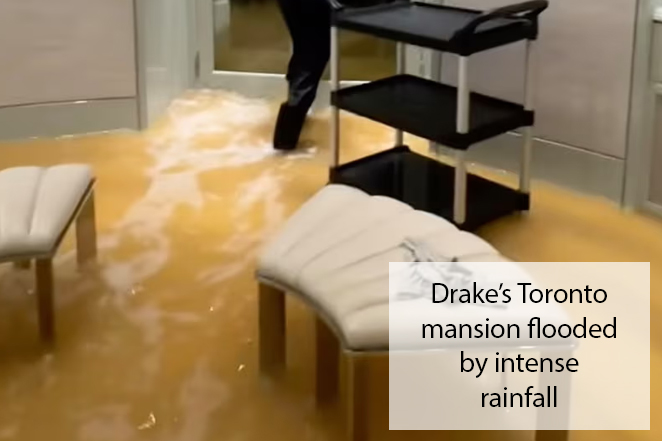
Toronto deluged by 3 months of rain in 1 hour
OMG Drake’s Mansion was flooded
OK, wildfires, droughts and heatwaves are one thing, but when it starts impacting major rappers’s lives, it’s time to take global warming seriously. The Toronto mansion of rap superstar Drake was flooded this week after record-breaking storms hit the Ontario capital.
Toronto got four inches of rain in an hour, which exceeded the 1941 record. Hundreds of thousands of customers lost power.
“This is the new reality. It used to be river flooding, now it is urban flooding.” – David Phillips, senior climatologist with Environment and Climate Change Canada
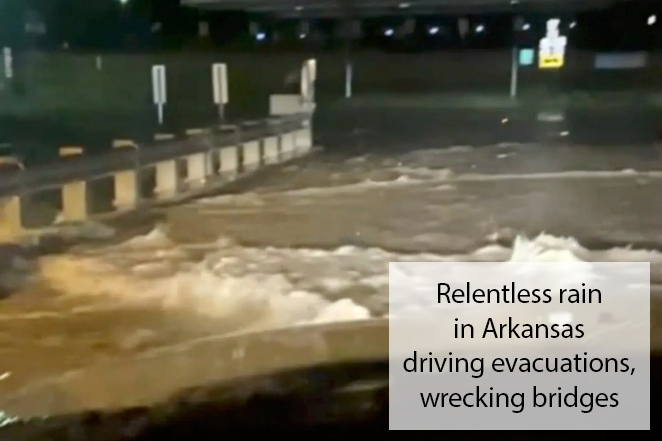
Extreme storms causing Arkansas evacuations
Unusual weather, ain’t it?
Record rainfall of 6 to 11 inches triggered a rare flash flood emergency in Marion County, where water was rising inside homes and bridges were washed-out.
The National Weather Service issued a flash flood emergency warning. which is unusual for the agency and happens only when catastrophic” damage is expected.
Water rescues and evacuations were carried out on July 17 as rising water inundated homes; at least one bridge had been washed out, another bridge was covered in water. One road was closed.
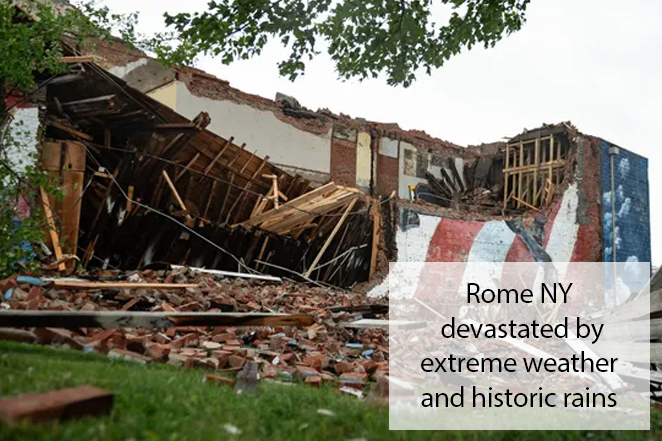
Rome, NY downtown laid waste by sudden storm
Downtown wrecked by intense storm
Major thunderstorms ripped through the upstate NY town of Rome Tuesday afternoon, wreaking havoc on the downtown area, destroying historic buildings and landmarks, leaving more than 15,000 people without power. A state of emergency was declared for Oneida County.
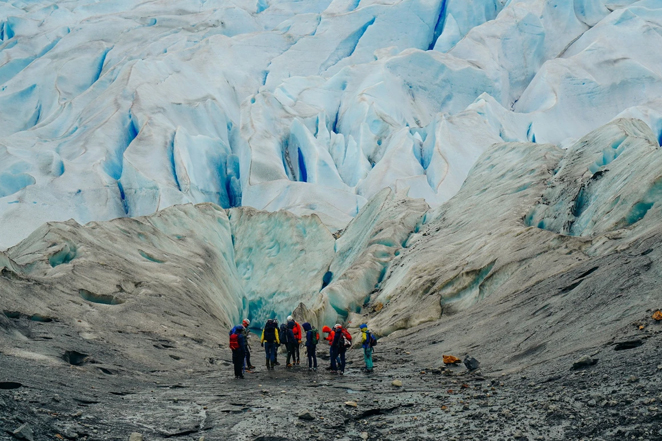
Juneau Alaska icefields virtually collapsing
50,000 gallons per second melt rate
According to a study just released in Nature Communications, the Juneau icefield current melt rate is unprecedented and accelerating. The regional snow cover is shrinking about five times fast than it was prior to 1980s, Between 2010 and 2020, it lost roughly 1.4 cubic miles of ice per year.
The Arctic is warming about 4 times faster than the rest of the planet. The petro state of Alaska itself has seen the average temperature increase 2.6 °F since 1980.
The acceleration in these fields is partially driven by one of the lower key feedback loops. As the ice thins it warms more quickly, exposing darker rocks which absorb more heat. This feedback inhibits the possibility for glaciers to regrow.
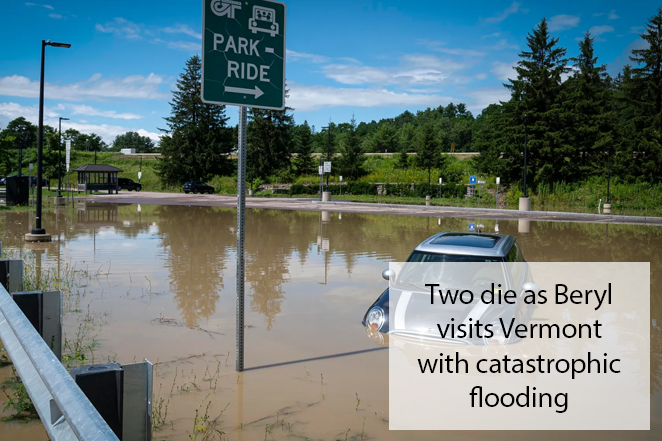
Beryl brings more lethal floods to Vermont
6,000 mile path of destruction in 14 days
After traveling 6,000 miles from the Atlantic Ocean, the record breaking storm known as Beryl reached New England, following up on last year’s lethal floods with more of the same. The “remnants” caused serious damage in the northern part of the region and heavy flooding which left two people dead in Vermont.
The storm washed away an apartment building, took out bridges and isolated towns, a replay of the catastrophic floods that slammed the mountain state a year ago to the day. More than 100 people were plucked out of the floods by swift water rescue teams.
“It’s like rewind to last year.”
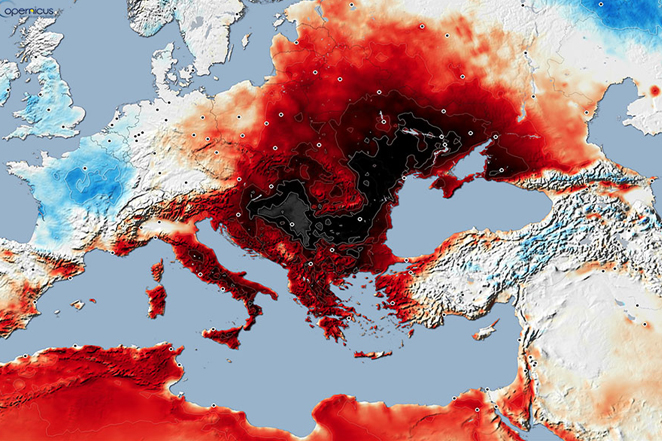
Climate whiplash afflicts Europe tourism
10% decline in visitors to southern Europe as some locations run out of water
In another sign of the creeping economic impact of the global warming disaster, southern Europe is experiencing a decline in tourism as heatwaves and wildfires threaten traditional vacation destinations.
Four people died in Italy as temps topped 100°F. Ancona, Bologna, Campobasso, Florence, Frosinone, Latina, Perugia, Pescara, Rieti, Rome, Trieste and Viterbo are under alert.
In Serbia, Croatia and Greece, forest fires are torching the countryside and melting pavement is reported in Belgrade.
Greek islands and some Italian vacation spots have run out of water as the peak season begins.
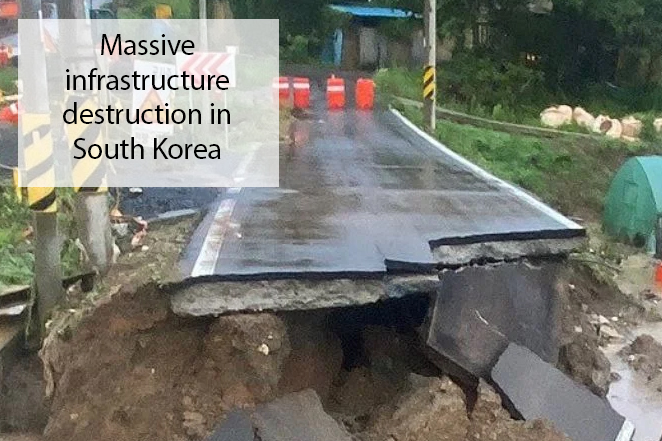
Extreme weather comes for South Korea
Four dead amidst evacuation of thousands
An extraordinary storm system brought climate catastrophe to South Korea in mid July. The record breaking rainfall was the most intensive seen in 200 years, wrecking infrastructure and killing four.
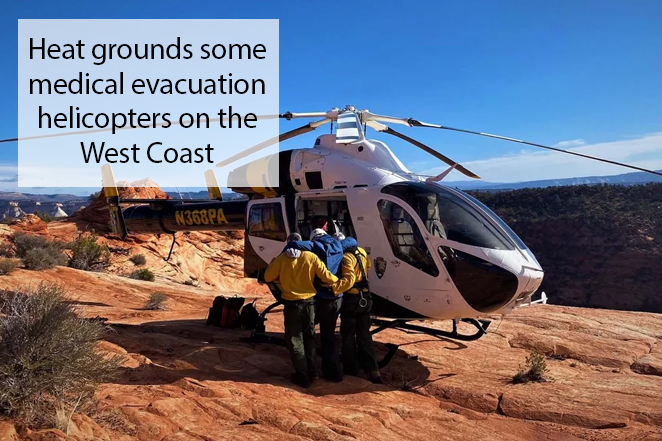
Some med evac choppers can’t fly due to heat
Rescue helicopters grounded in California
Some California helicopter rescues have been curtailed due to excessive temperatures, resulting at least one death.
The climate crisis brings a new set of unintended consequences every day. As temperatures are smashed on the West and East Coasts, at least one medical evacuation company has had to ground its equipment because it’s physically too hot to fly.
REACH Air Medical Services was forced to cancel two rescue fights in mid-July due to extraordinary temperatures. One motorcyclist died in Death Valley and another came near death; evac choppers were prevented from accepting the mission in Death Valley when temperatures hit around 129°F for several days running. When temperatures exceed 120°F degrees, medical helicopters often can’t take off, and their ability to maneuver is compromised because the a super heated atmosphere is not dense enough to provide lift. This is the same reason high altitude climbers can’t be rescued by chopper.
Some national parks in the region have begun warning visitors that a helicopter may not be able to reach them during heat waves.

World’s largest wetlands aflame in Brazil
“We expect it is only going to get worse.
Fires increase 1,500% over 2023
Over 1.8 million acres have been consumed by wildfire in the Brazilian Pantanal in 2024, as fires area surpass 2020, the previous worst year on record. The incidents of uncontained fires have increased 1,500% over 2023. According to officials, the fires throughout the region are turning the biologically special region into a charred wasteland.
The Home to over 3,500 plant species, more than 600 bird species, 124 mammals, 80 reptiles, 60 amphibians, and 260 freshwater fish species, Brazil’s Pantanal is burning as never before recorded in history.
“The impact is devastating. Animals are dying, wildfires are vanishing huge areas.” – Gustavo Figueirôa, biologist at SOS Pantanal. “We expect it is only going to get worse.”
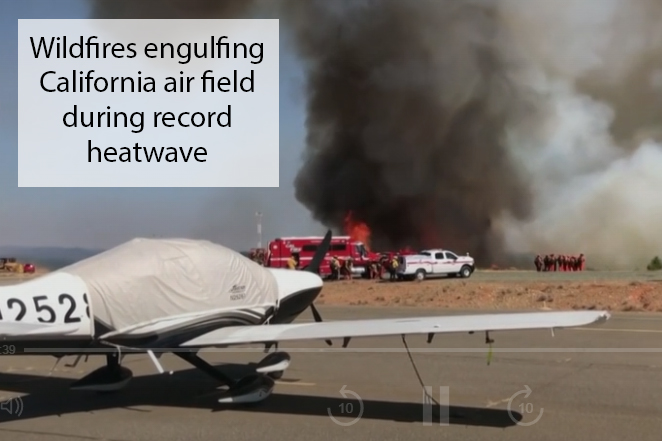
Wildfires threaten CA as evacuations continue
Neverland Ranch also threatened
The fire erupted on Friday near Zaca Lake, northeast of Los Olivos, Calif. As of early Monday, it had burned more than 20,000 acres and was 8 percent contained.
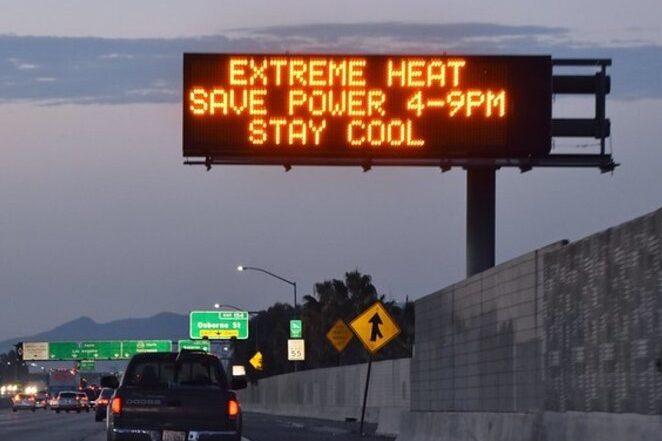
Record high temp records smashed on both coasts
Extended heat waves driving death toll
Death Valley temperatures are projected to stay around 130°F the second week in July as tens of millions in the US West see another record heatwave.
Consider the following:
- Portland, OR 103°F
- Raleigh, NC 106°F
- Boston, MA 103°F
- Las Vegas 120°F
- Palm Springs 124°
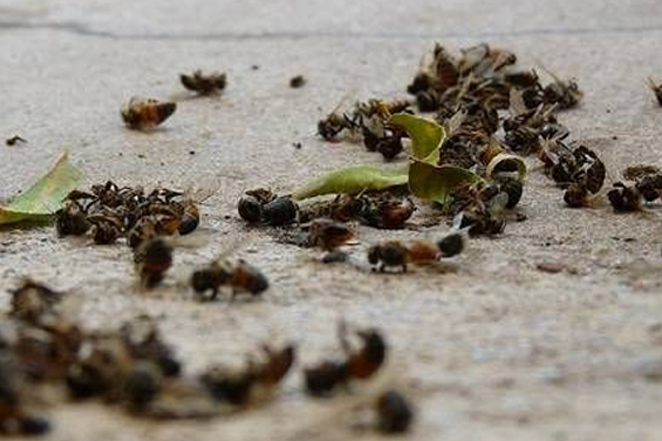
Baby bumblebees cooking
More than 200 fires already burning
According to a new study by University of Guelph, bumblebee babies are dying in their nests because global temperatures are getting too warm.
Runaway climate crisis is rapidly increasing the planet’s temperatures and now these temperatures have reached the point where nesting bumblebees are struggling to cope.
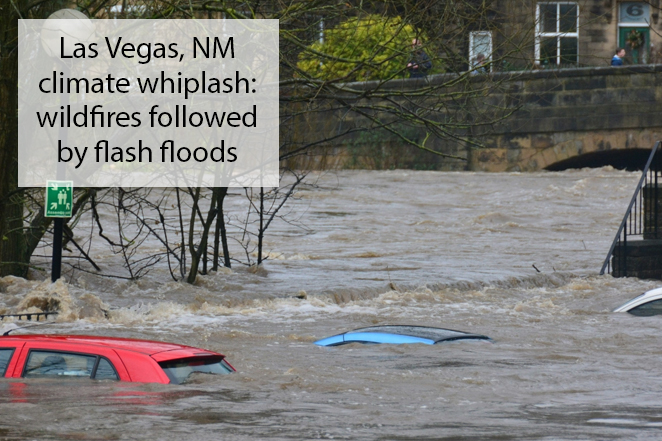
New Mexico Flash Floods
Climate Whiplash comes for Las Vegas, NM
Las Vegas, New Mexico, a historic town nestled in the heart of the state, is facing a climatic phenomenon that’s becoming all too familiar across the globe: climate whiplash. Defined as rapid shifts between extreme weather patterns, climate whiplash poses significant challenges to communities, economies, and ecosystems alike.
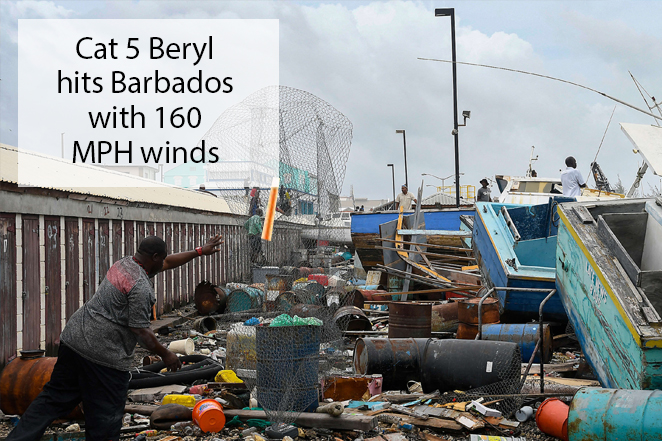
Killer Hurricane Beryl breaks things across the Gulf
Hot sea water temps are more like September
After having leveled 90% of the buildings on Carriacou, Grenada, Cat 5 Hurricane Beryl has already broken lots of records as it barrels toward Jamaica. The rapid intensification of this storm is unprecedented for this time of year (and for most any time of year), a condition made possible by Atlantic surface temperatures that are historically high. Rapid Intensification (RI) is defined as an increase of 35 MPH or more in a storm’s wind speed over 24 hours. Beryl’s wind speed more than doubled to 160 MPH from Monday to Tuesday.
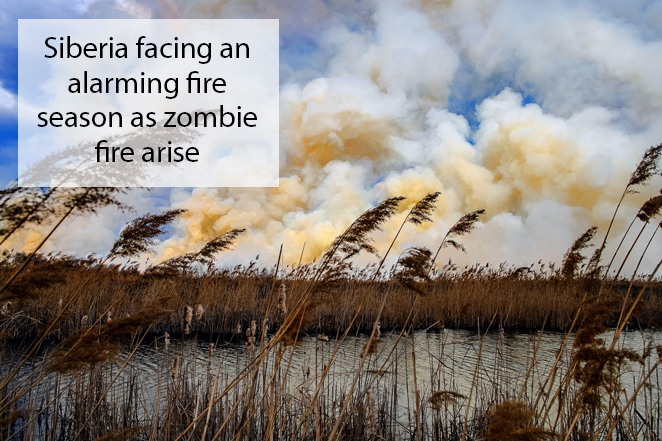
Zombie Fires spark Siberian wildfire season
More than 200 fires already burning
These peat fires, often referred to as “zombie fires,” smolder beneath the snow from the previous year’s wildfires and can quickly spread with the arrival of warm, dry conditions.
“At our place, the season lasts all year due to wintering peat fires,” said Anastasia, who became a volunteer after devastating wildfires hit the Sverdlovsk region in 2021, opening her eyes to the threats faced by nearby green areas.
The wildfire activity in the region follows a period of anomalously high surface air temperatures at the end of May, with forecast temperatures 7-9°C higher than normal, according to reports in the local media. Data from the Copernicus Climate Change Service (*C3S) confirms this, with negative (drier) soil moisture anomalies and positive (warmer) surface temperature anomalies in the first three weeks of June.